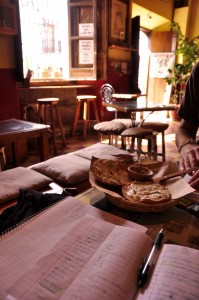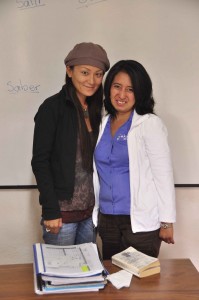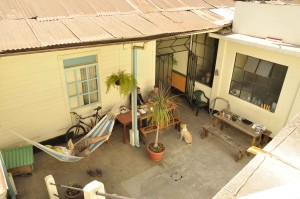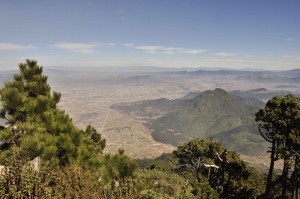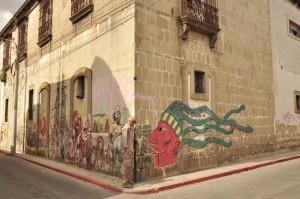Now I am not a cunning linguist by any stretch, rather I have a single mother tongue that I tend to use extremely well and often. When it comes to wrapping it around other dialects though, I am in all sorts of trouble. I did study French for 2 years at school when I was 13 or so and have since forgotten everything except how to ‘find the train station’ for some obscure reason that I can only attribute to disciplinary action. I briefly flirted with mandarin, but promptly found myself in Japan. And in my 8 years there I have picked up some Nihongo, but never really stuck with the lessons or seriously applied myself. In truth, I simply gravitated toward the Japanese comfort zone where I could handle myself well in a taxi or a bar, follow the gist of most conversations, intuit the rest and respond with the requisite affirmations or support somewhat effectively. Of course, Japanese is not exactly easy to pick up anyway, particularly the written forms which have a brute memorization component to it that is the stuff of nightmares. Still it does stand as one of my great shames and regrets in life, my lack of continued application and progress – particularly as I seem to be marrying into it 😉
And so to Spanish! Arriving in Latin America was the first time we have really confronted a language barrier in our travels I suppose. Generalizing of course, but in most countries, with the notable exceptions of France and Iran (and the Middle East where you need to know how to count in Arabic), you can get by in basic English with a little help from the requisite “hellos”, “please” and “thankyou’s” in the local lingo. Often we try and pick up more as we go along, but most of the time you are in another country before you know it, starting the process all over again. Here of course, it is Spanish all the way and for the next 6 months or so there was no avoiding it. A survival imperative beckoned – learn some quickly and get on top of it from the outset.
Thankfully though, Spanish is not Japanese and more a second cousin of English. This when combined with the fact that many Spanish words through films and books had found their way onto my radar already created a lot of encouragement for the linguistically challenged such as myself. Megumi by the way, who has studied a little Spanish previously living in the US, is a little further ahead, though still having difficulty trying to untangle it from her Italian. I had planned ahead for this challenge a little bit. Before leaving Japan, I had taken the time to download quite a few different language courses in MP3 format, something you could just throw on the IPOD and get amongst. I had ignored all the other lessons I had squirreled away up to this point – Laotian, Hindi, Arabic and Farsi, but the 2 different in depth courses on Spanish were particularly good. Over numerous bus trips as we worked our way down through Mexico to Central America, I found myself sitting in the corner, headphones on, mumbling crazily over and over to myself, like many of the street freaks we left behind in LA, San Francisco and the States in an attempt to get ahead.
Of course this combined with our initial travel through Mexico and Guatemala really helped just to get the basics going and the ears attuned. For real lessons we had decided we needed some serious study and that Guatemala was our best bet. Cheap lessons, pleasant environments and Spanish schools of esteemed repute, it had the right kind of ring and being at the start of the trip, offered an ideal timeline for onward travel. Our original plan had called for a month of study, possibly as part of a home-stay with a local family. But as our schedule had fallen behind and the potential to have to cram South America into a shorter period became more of a reality, something had to be sacrificed and we decided 2 weeks would have to do. Rather than simplify things and do 2 weeks back to back at a single destination, we decided to break this into 2, one week sessions split between Guatemala’s most famous Spanish teaching townships, Antigua and Quetzaltenango, more commonly referred to as Xela.
Antigua is a beautiful, colonial town, surrounded by volcanos on all sides, but a tourist mecca of sorts and very international. The cobblestone streets are full of pleasant cafés, international restaurants, churches and craft shops – all a welcome reprieve from the tortilla and bean diet simply unavoidable of late. Arriving on a Sunday, we found a comfortable place to stay and shopped around for a school. They are everywhere here and rather than investigate them all, we very quickly decided settled on a larger school, Maximo Nivel with a good reputation, customized textbook and opportunities for further study in Costa Rica or Peru. We booked in for a combined lesson starting the following afternoon.
Set around a pretty garden, we had 4 hours of lessons a day in a small room and quickly fell into a routine. We spent the morning working on memorizing vocabularies in one of the towns’ pleasant breakfast cafés, then the afternoon ensconced in lessons with our local teacher. In the evenings, there was a bit of homework and some more word memorization as follow-up. A full schedule, but the theory goes, it we were actually investing in study we may as well make the absolute most of it. It also helped learning with Megumi – Japanese do have the art of study, work ethic and application thing down. Suffice to say, she, happily aligned with my guilty conscience, proved to be a very positive influence.
Within a few days I was starting to build up a basic vocabulary and getting my head around the grammatical essentials. It is a big step in Spanish to be able to move beyond the basics of Hola (hello), Gracias (thankyou) and Soy de Australia (I’m from Australia) to start understanding the overall structure and mechanics of a conversation. In Spanish the two big initial hurdles for me were: 1) Comprehending the gender rules for everything and how that affects a word (ie a restaurant is male ‘el restaurante’, whereas a city is female ‘la ciudad’) and 2) that verbs are conjugated based on the personal context – I, you, we or they plus tenses. For example “to go (ir) somewhere” becomes Voy (I go); Vas (you go); Va (he/she goes); Vamos (we go); Van (they go). Believe me, it’s a big revelation understanding that you don’t just have to memorize 5 different words here and that they are all related. By the end of the week, this had all been mapped out and while my head hurt it was starting to make sense. I at least had a basic vocabulary in place to start prying things apart and getting under the bonnet.
Finishing our lessons in Antigua, we promptly made the transition to Xela on the Saturday and went about the same process – finding a comfortable hostel and a school. Xela offered quite a different approach, while schools here were everywhere, Xela is focused on more serious study, necessitating a much longer term, integrated and immersive study approach. Lessons here tended to be one on one only and packaged typically to include both food and accommodation, as part of an immersive home-stay with a local family. The town and environment itself is also much less touristy and feels more like an authentic Central American experience (complete with gunshots going off late at night). After talking to a few schools and hostals etc, we found a couple of standout school options – Celas Maya and another school, ‘Proyecto Linguistico Quetzalteco de Espanol’, a non profit run by the community with a program that was quite political, activist orientated and interesting. We decided on Celas Maya and nixed the idea of a homestay in favour of a cheap, homey hostel, Casa Renaissance, with kitchen (Essential for vegetarian cooking) plus the luxury of wi-fi. We were ready to start school Monday morning.
Lessons at Celas Maya were immediately of a lot higher intensity. No English is spoken at any point and there was nowhere to hide from the personal attention. One on one private lessons for 5 hours a day (plus an hour or so of breaks) gets you focused pretty quickly. I was very grateful we had done the 1 week study in Antigua beforehand – jumping straight in here would have been almost too much from scratch without some English interpretation. I found myself slotting into the same ritual though – working on memorizing the rapidly expanding vocabulary in the evenings and early mornings, lessons from morning til early afternoon and then joining one of the schools activities in the afternoon. Each day the school did a different excursion or activity for students to join (in Spanish of course) – we visited the oldest church in Central America (lame), went to natural sauna (curious) and learnt some traditional cooking (Nothing to show off).
Lessons were structured in a way to provide a clear daily progression, but the majority of the time was spent practically applying everything with in depth conversation. Now in my world, 25 hours of conversation with anyone usually entails a lasting friendship or some kind of intimacy. My Guatemalan teacher, with 15 years of experience at prompting conversation somehow got me sounding off in Spanish on subjects like Buddhism and the destructive cultural impacts of Christianity. Mostly however, she had this curious, almost spooky preoccupation with Japanese and never missed an opportunity to direct my new conversational talents toward explanations of the quirkiness that is the Japanese people and culture and the habits of my betrothed. She never asked me once about Australia though?
By the time a week was up though I was starting to drown and getting sick of talking about Japan. I guess I had crossed a threshold, able to communicate a large range of subjects in my own curious way, but at the same time I felt I was rapidly falling behind. Too many new words and rules were leading to lots of silly, repetitive grammatical errors creeping into the basics of my conversation. It became frustrating, as simple things got lost in the over extension. Perhaps this is just a natural phase of learning and part of the hard work that is the next stage of making this all come naturally. Personally,, I was relieved to finish.
In hindsight, another week or two of this would probably have been ideal in terms of getting me over the line with Spanish. I could see a finish line and a point where I could become quite comfortable quickly. As it was with a bit of thought, I can construct questions and answers to most of the basic things I need to do and follow the gist of most conversations. I had come a long way in a couple of weeks. Over the next few weeks as we hit the road again and started to put this to the test, I surprised myself with how much I did perceive, I was still a bit slow to process things and sometimes come over as a little retarded as I lag a few seconds behind a conversation trying to think it all through, but nothing too far out of reach. I still keep at the mp3 tapes, which have now started to make a lot more sense and really help with their practical memory reinforcement and application.
Megumi is still significantly ahead of me of course, but we were now able to immerse ourselves in a Spanish conversation and largely survive. Even to the point of spending several days with Spanish only speaking local guides which, while not perfect, was pretty encouraging. There was still a long way to go and perhaps another week of intensive lessons at some point might be still on the cards but in all it has been a very positive experience and easy to measure progress. Motivation enough for me to think of seriously again of applying myself to learning Japanese properly when I get home perhaps – I wonder how long I will last this time?
![On Learning Spanish Now I am not a cunning linguist by any stretch, rather I have a single mother tongue that I tend to use extremely well and […]](http://meltingplots.com/wp-content/uploads/2010/12/Top.jpg)
